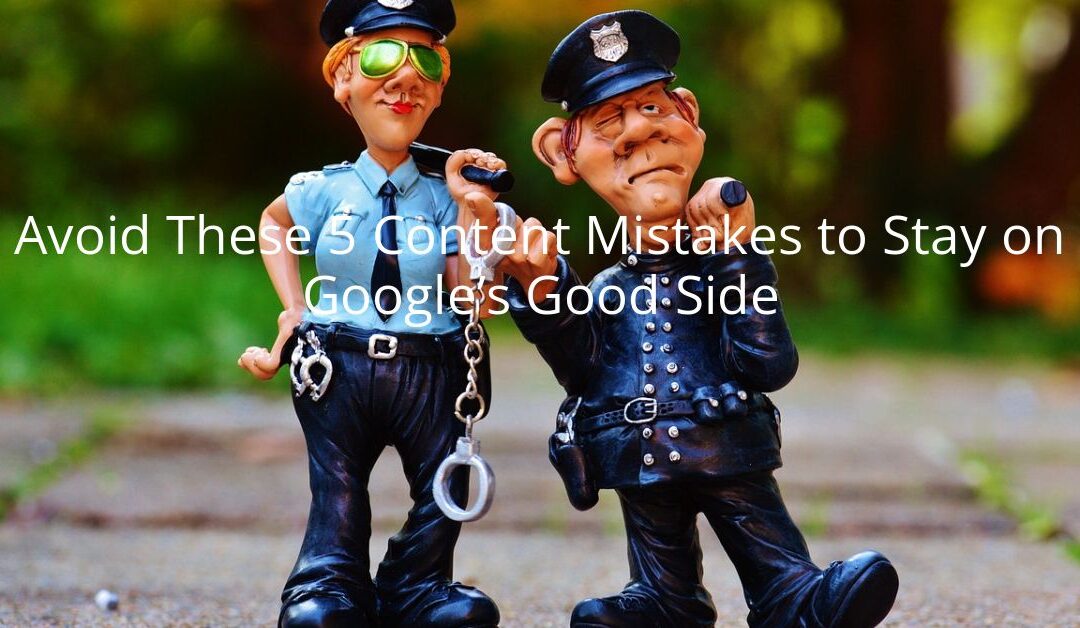 What if all that hard work on your website content actually backfired? Imagine pouring hours into writing, only to find your rankings slipping, your readers disengaged, and Google’s algorithm giving your site the cold shoulder. What went wrong?
What if all that hard work on your website content actually backfired? Imagine pouring hours into writing, only to find your rankings slipping, your readers disengaged, and Google’s algorithm giving your site the cold shoulder. What went wrong?
In the world of SEO, even seasoned writers and content creators can misstep, leaving Google, the silent but all-seeing digital giant, less than impressed. These common mistakes are easy to make, but the stakes are high: lose Google’s favor, and you could watch your hard-earned visibility vanish. The good news? Each of these mistakes is avoidable with a little fine-tuning and strategy. Here, we explore the top five content mistakes that can harm your Google ranking—and how you can steer clear of them.
Related: Link-Building 101: The Foundation for Powerful SEO Results
1. Keyword Stuffing: Trying Too Hard to Be Seen
 Remember the days of cramming keywords into every corner of your content, believing it would trick Google into giving you a higher ranking? Well, those days are long gone, and “keyword stuffing” is now more likely to get you penalized than promoted. Google has grown smarter—its algorithms now value readability, context, and user intent over sheer keyword density. Think of keywords as seasoning: a sprinkle enhances flavor, but too much leaves a bad taste.
Remember the days of cramming keywords into every corner of your content, believing it would trick Google into giving you a higher ranking? Well, those days are long gone, and “keyword stuffing” is now more likely to get you penalized than promoted. Google has grown smarter—its algorithms now value readability, context, and user intent over sheer keyword density. Think of keywords as seasoning: a sprinkle enhances flavor, but too much leaves a bad taste.
To avoid keyword stuffing, aim for a natural flow. Use your target keywords, but weave them into sentences that sound like an actual conversation rather than a robotic monologue. Google’s RankBrain, its machine-learning AI, can decipher synonyms and contextual cues, so don’t be afraid to mix things up a bit.
Pro Tip: Use tools like ContentERP’s keyword density checker to ensure you’re using keywords in a balanced, search-friendly way without overdoing it.
2. Thin Content: Skating on Shallow Ice
 Google’s crawlers are no strangers to thin content—articles that lack depth, insight, or real value. If your content simply scratches the surface of a topic, it risks being classified as “thin” and unworthy of high rankings. Think of thin content like a hollow shell: it may look good on the surface, but there’s no substance beneath it.
Google’s crawlers are no strangers to thin content—articles that lack depth, insight, or real value. If your content simply scratches the surface of a topic, it risks being classified as “thin” and unworthy of high rankings. Think of thin content like a hollow shell: it may look good on the surface, but there’s no substance beneath it.
To avoid this, make sure your content goes beyond the basics. Offer your readers insights, practical tips, and nuanced takes on your topics. Readers don’t just want to skim; they’re looking for something to take away, whether it’s new knowledge, a fresh perspective, or actionable steps.
3. Ignoring Mobile Optimization: Leaving Out Half of Your Audience
 In a world where smartphones dominate, creating mobile-friendly content isn’t optional—it’s essential. Google’s algorithms prioritize mobile-friendly sites because the majority of users are reading from their phones. Neglecting this audience is like putting up a “closed” sign in front of half your potential visitors.
In a world where smartphones dominate, creating mobile-friendly content isn’t optional—it’s essential. Google’s algorithms prioritize mobile-friendly sites because the majority of users are reading from their phones. Neglecting this audience is like putting up a “closed” sign in front of half your potential visitors.
Ensure your content is responsive and easy to navigate on all screen sizes. Break up long paragraphs, use bullet points, and include visuals that scale well. If a mobile visitor has to pinch and zoom or scroll horizontally, they’re likely to bounce, which sends a negative signal to Google.
4. Overlooking Meta Descriptions: Missing Out on Free Advertising
 Meta descriptions are the unsung heroes of SEO. Think of them as a mini-billboard: they give a glimpse of your content and invite readers in. However, too often, these crucial elements are neglected or left to auto-generate. A well-crafted meta description not only helps your click-through rate but also signals to Google that your content is relevant and valuable.
Meta descriptions are the unsung heroes of SEO. Think of them as a mini-billboard: they give a glimpse of your content and invite readers in. However, too often, these crucial elements are neglected or left to auto-generate. A well-crafted meta description not only helps your click-through rate but also signals to Google that your content is relevant and valuable.
To maximize your meta description, include your primary keyword and focus on creating an engaging summary. Aim to write a clear, compelling sentence or two that piques curiosity or promises value.
5. Failing to Update Old Content: Letting Gold Gather Dust
 Content is not a “set it and forget it” investment. Google favors fresh, relevant material. If you let your old content gather digital dust, it may start losing relevance—and ranking. Updating older pieces with new information, statistics, or perspectives signals to Google that your content is alive and continually valuable.
Content is not a “set it and forget it” investment. Google favors fresh, relevant material. If you let your old content gather digital dust, it may start losing relevance—and ranking. Updating older pieces with new information, statistics, or perspectives signals to Google that your content is alive and continually valuable.
To keep your older posts in Google’s favor, regularly audit your content. Identify popular pages that could use a refresh and add updates that reflect current trends or insights. Rewriting headlines, updating links, or even reformatting can breathe new life into existing posts, keeping them relevant and engaging.
Pro Tip: ContentERP’s content management tools make it easy to track your articles, identify content that’s due for an update, and even suggest new keywords based on current SEO trends.
Conclusion: Don’t Let These Simple Missteps Hold You Back
 Imagine your website as a bustling café: readers stream in, staying to savor the information, engaging with the conversation, and coming back for more. But when mistakes like keyword stuffing, thin content, or a lack of mobile optimization sneak in, it’s like the lights are dimming, chairs are out of place, and the espresso machine is broken. The magic fades. By avoiding these five common errors, you keep your content inviting, relevant, and always on Google’s radar.
Imagine your website as a bustling café: readers stream in, staying to savor the information, engaging with the conversation, and coming back for more. But when mistakes like keyword stuffing, thin content, or a lack of mobile optimization sneak in, it’s like the lights are dimming, chairs are out of place, and the espresso machine is broken. The magic fades. By avoiding these five common errors, you keep your content inviting, relevant, and always on Google’s radar.
At ContentERP, we understand the fine line between creative expression and SEO rigor. Our tools are designed to help you craft content that resonates with readers and stays in Google’s good graces. Ready to see the difference that streamlined, optimized content creation can make? Sign up with ContentERP today and take your content strategy to the next level.
Related: Keep Viewers Watching: 7 Tips to Increase YouTube Watch Time

